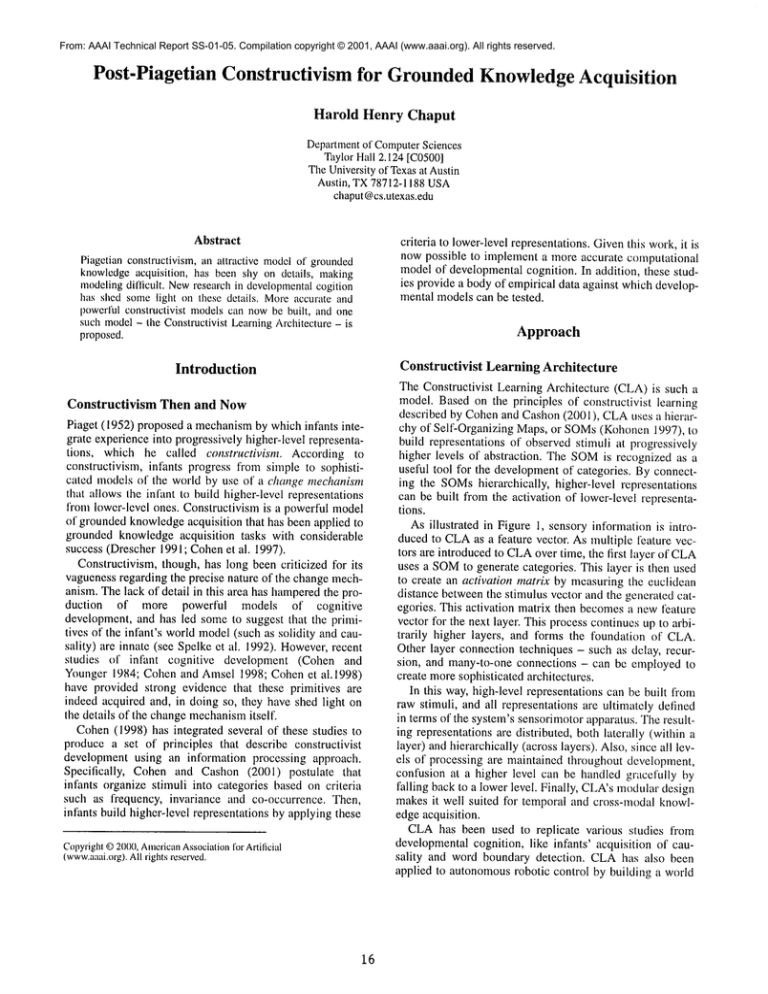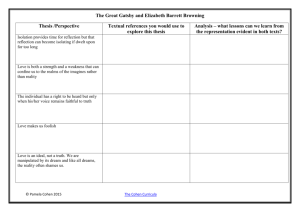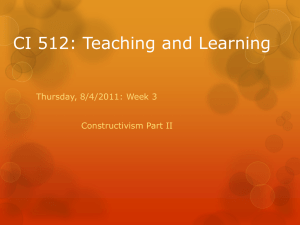
From: AAAI Technical Report SS-01-05. Compilation copyright © 2001, AAAI (www.aaai.org). All rights reserved.
Post-Piagetian
Constructivism for GroundedKnowledge Acquisition
Harold
Henry Chaput
Departmentof ComputerSciences
TaylorHall 2.124 [C0500]
TheUniversityof Texasat Austin
Austin, TX78712-1188USA
chaput@cs.utexas.edu
Abstract
Piagetian constructivism, an attractive modelof grounded
knowledgeacquisition, has been shy on details, making
modelingdiflicult. Newresearch in developmental
cogition
has shed somelight on these details. Moreaccurate and
powerfulconstructivist modelscan nowbe built, and one
such model- the Constructivist LearningArchitecture- is
proposed.
Approach
Constructivist
Introduction
Constructivism
criteria to lower-level representations. Giventhis work,it is
now possible to implementa more accurate computational
modelof developmentalcognition. In addition, these studies provide a bodyof empirical data against whichdevelopmetatal modelscan be tested.
Then and Now
Piaget (1952) proposed a mechanismby which infants integrate experience into progressively higher-level representations, which he called constructivism. According to
constructivism, intants progress fi’om simple to sophisticated models of the world by use of a change mechanism
that allows the infant to build higher-level representations
from lower-level ones. Constructivism is a powerful model
o1’ groundedknowledgeacquisition that has been applied to
grounded knowledgeacquisition tasks with considerable
success (Drescher 1991; Cohenet al. 1997).
Constructivism, though, has long been criticized for its
vaguenessregarding the precise nature of the change mechanism. The lack of detail in this area has hamperedthe production of more powerful models of cognitive
development, and has led someto suggest that the primitives of the int~nt’s world model(such as solidity and causality) are innate (see Spelke et al. 1992). However,recent
studies of infant cognitive development (Cohen and
Younger 1984; Cohen and Amsel 1998; Cohen et a1.1998)
have provided strong evidence that these primitives are
indeed acquired and, in doing so, they have shed light on
the details of the changemechanism
itself.
Cohen(1998) has integrated several of these studies
produce a set of principles that describe constructivist
development using an information processing approach.
Specifically, Cohen and Cashon (2001) postulate that
intants organize stimuli into categories based on criteria
such as fi’equency, invariance and co-occurrence. Then,
infants build higher-level representations by applying these
Copyrighl
©2000,American
Association
[’or Artificial
(www.aaai.ot~.).
Allrightsreserved.
16
Learning Architecture
The Constructivist Learning Architecture (CLA)is such
model. Based on the principles of constructivist learning
described by Cohenand Cashon(2001), CLAuses a hierarclay of Self-Organizing Maps, or SOMs(Kohonen1997),
build representations of observed stimuli at progressively
higher levels of abstraction. The SOMis recognized as a
useful tool for the developmentof categories. By connecting the SOMshierarchically, higher-level representations
can be built from the activation of lower-level representations.
As illustrated in Figure 1, sensory information is introduced to CLAas a feature vector. As multiple feature vectors are introduced to CLAover time, the first layer of CLA
uses a SOMto generate categories. This layer is then used
to create an activation matrix by measuring the euclidean
distance betweenthe stimulus vector and the generated categories. This activation matrix then becomesa newfeature
vector for the next layer. This process continues up to arbitrarily higher layers, and forms the foundation of CLA.
Other layer connection techniques - such as delay, recursion, and many-to-one connections - can be employed to
create moresophisticated architectures.
In this way, high-level representations can be built fi’om
raw stimuli, and all representations are ultimately defined
in terms of the system’s sensorimotorapparatus. The resulting representations are distributed, both laterally (within
layer) and hierarchically (across layers). Also, since all levels of processing are maintained throughout development,
confusion at a higher level can be handled gracefully by
falling back to a lower level. Finally, CLA’smodulardesign
makes it well suited for temporal and cross-modal knowledge acquisition.
CLAhas been used to replicate various studies from
developmentalcognition, like infants’ acquisition of causality and word boundary detection. CLAhas also been
applied to autonomousrobotic control by building a world
[]
[]
[]
[]
p~
--. |..r~..
Input Vector
CLALayer 1
CLALayer 2
...and so on.
Figure 1: The progression of information in the Constructivist Learning Architecture. Layer 1 organizes several input
vectors into categories. These categories are then comparedto the Input Vector to generate an activation matrix. The
activation matrix then becomesthe input vector for Layer 2, whenalso generates an activation matrix, and so on.
model through interaction with the environment and using
this world model to develop environment-appropriate
behaviors and recover from sensor trauma.
Conclusion
Developmentalcognition is a powerful modelfor grounded
knowledgeacquisition. The new discoveries comingout of
developmentalpsychologyare providing the details necessary to create a new generation of infant learning models
that are more accurate and more powerful. Robots can use
these models to generate the knowledge necessary for
robust and sophisticated behavior. Indeed, the developmental approach can be employedin a wide variety of domains
that wouldbenefit from groundedrepresentations, such as
language and commonsense reasoning. And by building
models of developmental cognition, we can further understand the process of humanlearning itself.
References
Cohen, L. B. 1998. An information processing approach to
infant perception and cognition. In Butterworth, G., and
Simion F. eds. Developmentof Sensory, Motor, and Cognitive Capabilities in Early Infancy: FromSensation to Cognition, 277-300. East Sussex: PsychologyPress.
Cohen,L. B and Amsel, G. 1998. Precursors to infants’ perception of causality, h~’ant Behavior & Development21
(4), 713-732.
Cohen, L.B.; Amsel, G.; Redford, M. A.; and Casasola, M.
1998. The developmentof infant causal perception. In Slator, A. ed. Perceptual Development:Visual, auditory and
speech perception in infancy. London:UCLPress and Taylor and Francis.
Cohen,P. R.; Atkin, M.; Oates, T.; and Beal, C. P.. 1997.
Neo: Learning conceptual knowledge by sensorimotor
interaction with an environment.In Proceedingsof the First
International Conference on AutonomousAgents. 170-177.
Cohen, L. B. and Cashon, C. H. 2001. Infant object segregation implies information integration. Journal of Experi-
17
mental Child Psychology. Forthcoming.
Cohen, L. B. and Younger,B. A. 1984. Infant perception of
angular relations. Infant Behavior and Development,7, 3747.
Drescher, G. L. 1991. Made-UpMinds, a Constructivist
Approachto Artificial Intelligence. Cambridge:MITPress.
Kohonen, T. 1997. Self-Organizing Maps. New York:
Springer-Verlag.
Piaget, J. 1952. The Origins of Intelligence in Children.
NewYork: International Universities Press. (Originally
published 1936.)
Spelke, E. S.; Brienlinger, K.; Macomber,J.; and Jacobson,
K. 1992. Origins of knowledge.Psychological Review, Vol.
99, No. 4, 605-632.








